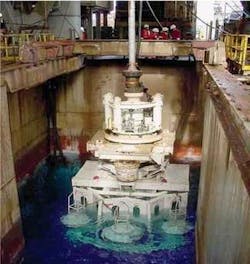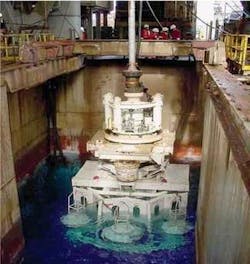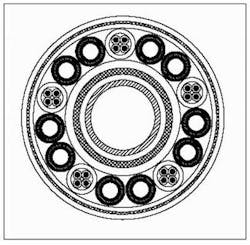Drill pipe riser intervention improvements aim at FPUs
Two systems resulted from developments for deep, ultra deepwaters
Carlos Henrique da Silva, Roberti Hilário Ribeiro - Petrobras S.A.
Petrobras S.A. discovered the Roncador field in 1996 in 1,800 m of water, which accelerated development of a new completion and intervention system. The dual-bore risers used at the time were too heavy for application in this ultra deepwater field and extended tripping times while exhibiting poor gas sealing capability.
Petrobras initiated a project with FMC to develop the Drill Pipe Riser Intervention System (DPRIS) in 1997. Actual delivery came in 1999. When this project began, Petrobras identified the need for a mobile early production riser for use with a floating production unit dedicated to an extended flow test of new or recently discovered production. The development project met these two different needs, and as a result the DPRIS was delivered with two options: as a DPRIS and as an Early Production Riser (EPR).
DPRIS use expanded from the initial two systems to the eight systems presently operating. During this period, key DPR components evolved from a DPR system with electro-hydraulic multiplexed control into a direct hydraulic control simplified DPRIS.
Development
Before the DPRIS, Petrobras used regular drill pipe available at the rig to install the production adapter base, and for tree cap installation and retrieval. These were simple, open-sea operations that did not require annulus control, pressure containment, or fluids circulation. Using drill pipe also reduced tripping times. The company used drill pipe a few times in tubing hanger retrieval operations. Pipe would run with a hydraulic jar to release a stuck tubing hanger. Success varied, but the difficulties and risks of a hydraulic umbilical inside the drilling riser were identified.
Existing dual-bore risers were adequate for the shallow water completions in the Campos basin. As time passed and subsea completions moved to increasingly deeper waters, these risers became a poor solution.
The company’s main drives for the development of FMC’s DPRIS with electro-hydraulic multiplex control were:
- Weight reduction
- Faster tripping times
- Larger production bore
- Improved sealability
- Greater degree of control on operations
- Monitoring electrical sensors during installation.
However, a few restrictions or limitations on the use of the system were acknowledged. These included:
- Restricted ID for annulus access or circulation
- The DPRIS is not NACE compliant
- Multiplex control system requires a NAS Class 6 cleanliness level
- The annulus bore is not accessible for wireline operations.
Open sea mode operations
In the “open sea mode” when installing the production adapter base and when installing or retrieving the tree or the tree cap, operations are fairly simple and straightforward, as described below:
- Access for inspection by ROV is easy, whether at sea bottom or along the string, providing visual control for the operation
- There are little space restrictions or size limitation for the DPRIS equipment or accessories
- Running drill pipe is done from the rig floor using regular slips with low mark dies. The running operation for the umbilical and clamps is done at the moon pool
- Full use is made of the multiplex control, with selective actuation of up to 40 hydraulic functions. In the open sea mode, the multiplex control offers better control.
Tubing hanger mode
The complexities and difficulties operating the DPRIS in “tubing hanger mode” include:
- The operation is performed inside the drilling riser where there is no visual access and the operator relies on instrument readings and other indications for control
- There always is relative motion between the drill pipe and the drilling riser (when running in or pulling out) or between the drill pipe and the rig (when the tool is connected at the bottom). This relative motion is apt to damage the umbilical or the clamps
- This mode operates in direct hydraulic control, which gives the benefits of monitoring downhole sensors plus providing quick disconnection of the running tool
- A special set of power slips are required to run the drill pipe with the umbilical and clamps
- Clamp failure results in them falling inside the drilling riser, potentially causing a difficult fishing operation.
The tubing hanger mode for the DPRIS is similar to the drill stem testing operations with subsea test trees, except for the size of the umbilical. It is larger for the DPRIS.
Using drill pipe had some unique and immediate benefits such as weight reduction, faster tripping times, and improved sealability. These produced an immediate positive effect on efficiency.
Monitoring downhole sensors
Another breakthrough was the possibility of monitoring downhole sensors while installing the tubing hanger. This was more valuable when installing intelligent completions with multiple downhole sensors and actuators.
The multiplex control of the DPRIS gave greater control over operations. A positive effect comes with time and extensive training of personnel. On the other hand, the multiplex control requires a lengthy setup and a high level of hydraulic system cleanliness, which is a disadvantage. It is important to note that when Petrobras substitutes multiplex control for a direct hydraulic control, the DPRIS becomes a much more accessible technology to a greater number of manufacturers or service companies in the oilfield business.
After all these factors were analyzed, the decision was to have a direct hydraulic control simplified DPRIS operating side by side with the originally developed multiplex control DPRIS. As a result, the direct hydraulic simplified DPRIS has been in operation since June 2003 under a service contract.
Apart from the control system which represents an obvious difference, the direct hydraulic control simplified DPRIS has a different umbilical and circulation hose configuration when operating in the open sea mode. The large number of hydraulic functions of the tree and running tool are supplied from the surface, requiring a minimum of 32 hydraulic lines and three electrical “quads” to fit into a single umbilical. The HCR hose for annulus control is run separately on a second reel.
Trade-offs
Clearly there are significant trade-offs involved when the option is to use the multiplex control DPRIS. On the beneficial side, there are a number of convenient electronic safeguards and features such as:
- Positive indication of functions actuated
- Safe disconnection
- Improved overall safety
- Inclinometer.
On the restrictive side:
- Lower readiness
- Restricted market availability
- Higher maintenance and operation costs.
When the option is to use the simplified DPRIS there is no significant trade-off. The simplified DPRIS presents all those benefits that have already been described while retaining the use of the well-known direct hydraulic control system.
Spider improvement
Petrobras found the spider to be the key to tripping drill pipe in tubing hanger mode. It has the triple function of setting and holding the drill pipe against the rotary table, providing an opening large enough for passing the drill pipe plus the large OD umbilical and clamps, and providing some centralizing effect while running in or out of the well.
The spider initially delivered with the DPRIS was improved and its robustness increased. There are two designs of spiders operating with the DPRIS. Besides having adequate handling equipment, operation of the DPRIS in tubing hanger mode depends on the skills of the rig crew.
Umbilical improvement
Several design and manufacturing changes to the umbilical were introduced over the course of this project to make it more tolerant of offshore operations. Despite Petrobras’s improvements, the fact remains that the offshore operation, particularly the tubing hanger mode, is very hard on the umbilical. The main changes in design and in manufacturing were:
- Having the seawater to pressure balance across the aramid fibers layers on the HCR hose
- Tighter control during manufacturing and testing of the HCR hose to avoid any residual torsion
- Placing an intermediate aramid fiber layer on the external sheath of the umbilical to increase its tension capacity
- Placing an intermediate aramid fiber on the individual cables for extra protection and to minimize risk of damaging the cables.
null
Annulus hose modification
The 1-in. HCR hose originally developed for annulus access and for circulation had limited flow capacity, severely restricting some operations. Killing a well requires reverse circulation and displacing fluids inside the drill pipe at a higher flow rate than can be achieved with the 1-in. HCR hose. To lift that restriction, a 1 1/4-in. HCR hose was developed and made available in 2 different forms:
- A new electro-hydraulic umbilical with the 1 1/4-in. HCR hose at the center
- As a separate 1 1/4-in. HCR hose to be used separate from the control umbilical.
The company’s option of an HCR hose integrated with the electro-hydraulic umbilical is preferred for use with the Multiplex Control DPR System. This option of a separate HCR hose is being used with the Direct Hydraulic Simplified DPR System. It is important to note that the option was left open for using a 1 1/2-in. HCR hose, if necessary.
Multiplex control improvements
Petrobras’s experience with the DPR Intervention System led to the following improvements:
- Several changes to the master control station gave better functionality and made it more user-friendly
- Improvements to the subsea control module made it more tolerant to find control fluid impurities
- Additional sensors were added to give better operations control. These additional sensors include an inclinometer at the stress joint, proximity switches for monitoring disconnections at the emergency disconnect package, pressure monitoring for hydraulic accumulators, and others.
Of the restrictions to the use of the DPRIS, it is important to note that the industry is giving signs that a fully NACE compliant drill pipe will be available in the near future. As for the fragile electro-hydraulic umbilical in tubing hanger mode, there are studies to reduce it to a single electric cable, moving the hydraulic power generation to the running tool, with great simplification on tripping the drill pipes in and out of the drilling riser.
Acknowledgements
The authors thank all Petrobras and FMC professionals who kindly presented comments and suggestions during the preparation of this paper.
Editors Note:This is a summary of the DP Riser paper presented at the DOT XVII Conference Nov. 8-10, 2005, in Vitoria, Brazil.



